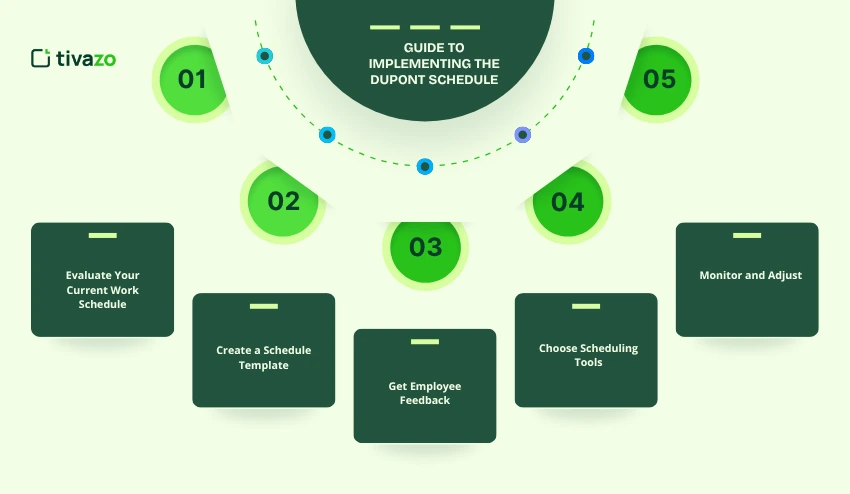Are you frustrated with inconsistent schedules, exhaustion, and low productivity in your workforce? You are not alone; millions of companies have difficulty maintaining a healthy balance between employee productivity and work-life balance. That’s where the DuPont Schedule comes in. Using the DuPont Schedule is more than just structuring shifts — it’s an effective workforce scheduling system that is a unique approach to managing shift schedules, which is used in a variety of industries, even by some of the greatest successes in the world.
The DuPont Schedule is a unique shift scheduling process that balances productivity and fatigue, and focuses on keeping employees engaged and well. But what is it, and how can it benefit your organization?
In this article, we’ll cover everything you need to know about the DuPont Schedule. You’ll learn the background, the values, and principles of the DuPont Schedule, and ways to implement it into your workplace. Look, by the end of the material in this blog, you will have the full picture of how implementing the DuPont model can make your team more efficient, useful, and balance personal time with work time.
Key Highlights:
- What is the DuPont Schedule
- Benefits of the DuPont Schedule
- DuPont Schedule vs Other Shift Models
- Guide to Implementing the DuPont Schedule
- Challenges of the DuPont Schedule and Solutions
What is a DuPont Schedule?

The DuPont Schedule is a shift-based work framework invented by DuPont (the massive multinational chemical company) to effectively manage its 24/7 workforce. The DuPont scheduling system usually consists of predominantly 12-hour rotating shifts where workers alternate in 24-hour cycles, in a way that mitigates excessive fatigue while maximizing rest.
The DuPont work schedule is:
- Four-week cycles,
- Four teams, and
- Two 12-hour work shifts, day and night.
The DuPont Schedule can differ from typical 5-2 or 4-3 schedules in that it can maximize efficiency for the employee and be more flexible for the employer. For example, the DuPont Schedule will mostly be a 4-3 cycle; a cycle with four consecutive work days followed by three days off. This allows the business to get complete days of coverage while ensuring the employee is more rested and recovered from work-related demands.
5 Key Benefits of the DuPont Work Schedule
Key Benefits of the DuPont Schedule:

1. Boosts Employee Productivity
The increase in employee productivity is one of the key advantages of the DuPont Schedule. With longer breaks between shifts (3 days), employees come back to their shifts feeling more rested and invested. This results in fewer mistakes, better focus, and a higher quality product.
When employees are not overworked, they can do more with their time. This is especially true with jobs that require a higher level of focus and physical stamina, like production or health care.
2. Better Work-Life Balance
The DuPont Schedule also promotes a better work-life balance than the typical 9-to-5 work schedule. Employees experiencing longer time off have more time to spend with their families, pursue hobbies, or rest. This results in less employee turnover and better employee satisfaction.
When employees feel that they can recharge and have sufficient time for themselves, they are more likely to remain loyal to your company, which means lower recruitment and training costs for your company in the long term.
3. Reduces Shift Fatigue
In industries that run 24/7, shift fatigue is a serious issue. The DuPont Schedule distributes and rotates shifts, both days and nights, and allows employees to rest between rotations to combat fatigue. In turn, the decline in employee fatigue leads to a decrease in sick days and healthier employees.
The DuPont Schedule is also helpful in managing employees’ natural circadian rhythms, allowing for recovery periods with built-in, non-working time off.
4. Cost-Effective Workforce Management
The DuPont Schedule workforce is organized efficiently and helps the organization save costs on overtime while providing proper management of workforce overhead. Organizations can cover their shifts in the best manner possible without straining employees through excessive overtime or adding more employees, allowing organizations to manage resources that are less expensive in the long run.
5. Scalable for Large Teams
The DuPont Schedule schedules perfectly for larger teams. The DuPont Schedule is also a completely scalable scheduling method for organizations with a need for 24/7 operations. When organizations implement a DuPont Schedule for their workers during the growth phase, this system manages multiple shifts with minimal downtime, ensuring all shifts are properly filled.
DuPont Shift Schedule vs Other Shift Models
The DuPont Schedule offers advantages over other common shift systems like the 4-3 or 5-2 schedules. Unlike the traditional 5-2 model, which requires employees to work five consecutive days, the DuPont Schedule provides three days off, which gives employees more time to rest, resulting in better overall health and increased efficiency.
| Shift Model | Work Days | Days Off | Rest Periods | Employee Benefits | Common Use Case |
| DuPont Schedule | 4 days on, 3 days off | 3 days | Long rest between shifts | Increased productivity, better work-life balance | Manufacturing, Healthcare |
| 4-3 Schedule | 4 days on, 3 days off | 3 days | Similar to DuPont but less flexible | Balanced rest, but less common in large-scale industries | Flexible jobs |
| 5-2 Schedule | 5 consecutive days on | 2 days | Shorter rest, higher fatigue | Consistent but less restful for employees | Office jobs, Retail |
| 12-Hour Shifts | 12 hours on, 12 hours off | 3-4 days | Potential for exhaustion with long shifts | High fatigue risk, needs regular breaks | Emergency services, Hospitals |
Pros and Cons of DuPont Schedule
Below is a clear comparison table outlining the advantages and disadvantages of the DuPont schedule, including key factors such as work-life balance, productivity, and rotating 12-hour shifts. This helps employees and employers understand whether the DuPont shift schedule is the right fit for continuous 24/7 operations.
| Pros of the DuPont Schedule | Cons of the DuPont Schedule |
|---|---|
| Provides a built-in 7-day break every 4-week cycle, improving work-life balance | Long 12-hour rotating shifts can be physically and mentally demanding |
| Fewer shift handoffs, improving safety and operational continuity | Switching between day and night shifts may disrupt sleep patterns and health |
| Ideal for 24/7 operations with consistent staffing and coverage | Harder for employees to maintain regular routines outside of work |
| Balanced rotation prevents overworking a single team with too many weekends or nights | Requires strong scheduling and communication to avoid coverage issues |
| Helps improve productivity, efficiency, and equipment uptime | May increase fatigue during long work blocks (3–4 consecutive days) |
| Allows predictable scheduling for family time, vacations, and personal planning | Can be challenging for new employees to adapt to long cycles |
How to Customize the DuPont Schedule for Your Business (250-300 words)
The DuPont Schedule is a highly flexible and customizable schedule that you can adapt to your organization’s operational needs. When modifying, you should consider shift rotation cycles, shifts worked, and time off. Moreover, for industries like manufacturing or healthcare, where employees often work for 24/7 operations, you can easily change shift length (i.e., 12-hour shifts) and provide additional staffing requirements. Employees’ preferences are also important; some employees prefer fixed shifts, while others prefer a rotation. Getting their input is important to ensure they are happy with their work schedule and to avoid burnout.
You may need further adjustments due to seasonal needs. For example, during peak work periods, you can extend shifts or rotate more often when you are busy, and return to your regular DuPont rotation after the busy season ends. Industry needs, employee feedback, and seasonal needs can all be considered when adjusting the DuPont Schedule to allow for better work productivity and employee engagement.
How Does the Dupont Schedule Work? Step-by-Step Guide
When your organization decides to adopt the DuPont Schedule, there are some steps to take to make the transition smooth and realize the benefits involved:

1. Evaluate Your Current Work Schedule
Before implementing the DuPont Schedule, it is valuable to assess your current work schedule, noting what can be better. This will give you some insight into how the DuPont Schedule can mitigate the challenges you have. Start the assessment with some challenges, such as new employee burnout, high turnover, absenteeism, or low productivity.
You can conduct surveys or focus groups, and discuss influencing factors with employees about their existing method of shifts, particularly about any level of discomfort. You will want to know how, or if, they will feel that staying with the current scheduling has value, motivation, and clarity. Also to be reviewed would be operational needs and where gaps could make applications of the DuPont Schedule more effective or efficient.
2. Create a Schedule Template
Once you have evaluated the existing schedule, you can develop a DuPont work schedule template. The DuPont schedule is usually a 4-3 schedule – you will work for 4 days and have 3 days off. The schedule model not only gives staff time to rest but also assures your operation is fully staffed 24/7. You can adjust the hours. For example, 12-hour shifts or longer shifts, if you decide that works for your team. As you develop your work schedule template, remember that it is complicated to schedule a large team, and you should also consider scheduling an overlap for shifts. In addition, it would be good to ensure that all shifts are covered.
3. Get Employee Feedback
Having your employees involved in the process is important for the successful implementation of the DuPont Schedule. It is critical to have employee buy-in, which will help to minimize resistance to the new system. You should have a meeting with your employees or hold focus groups to discuss their opinions and input on the proposed shift rotations. For example, employees may not like the balance of life/work or how the schedule will affect their personal lives, and may have concerns. By listening to your employees’ concerns and suggestions, you can adjust the schedule accordingly and increase its appeal. Additionally, involving the employees in the process helps with ownership and accountability that will lead to better job satisfaction and results.
4. Choose Scheduling Tools
When managing the DuPont Schedule, you would want to utilize employee scheduling software, which will automate the entire scheduling process. The DuPont Schedule has complex shifts; therefore, scheduling tools are necessary to ensure structure, accuracy, and efficiency. Scheduling tools help you schedule shift rotations, keep track of time, and account for employee availability. These tools will help to automate the scheduling process and also provide access to real-time information on employee performance and attendance.
By tracking employee performance and attendance, if there are any troublesome issues with the schedule, you can be able to quickly adjust things to find a solution. Automating scheduling will mitigate human error and make managing large teams much easier, and will ensure that shifts will never be missed!
5. Monitor and Adjust
Once you have implemented the DuPont Schedule, it is important to continue to monitor its effectiveness. Consistent monitoring will help you identify any potential issues early on, such as fatigue levels, employee displeasure, or shift coverage dilemmas. Use performance reviews, employee surveys, or productivity reports to monitor key indicators for your team. For example, fatigue levels: If employees are telling you they are too tired or burnt out, you may need to rethink your rotation or staffing support.
Feedback loops are really important to keep participation alive with employees. If you have collected any data, do not be afraid to modify the schedule to influence an improvement. You may find that extending rest periods, changing the shift time (e.g., 7-3 to 8-4), or providing certain teams with flexibility yields better outcomes. Over time, your business will shape the DuPont Schedule to best meet the needs of the employees and organization.
DuPont Schedule for Night Shifts
Night shifts are hard work! The DuPont Schedule offers methods for maximizing rest breaks between shifts and allows for optimum shift rotation. Employees working night shifts will always experience fatigue, disruption, unwanted sleep cycles, and reduced productivity. The DuPont rotating schedule takes into account recovery time, reducing some of the negative impacts of night shifts.
The very best means of maximizing night shifts is to have a balanced rotation of day shift and night shift, which also means that no workers are rolled into consecutive night shifts. Wellness programs, regular breaks, and tips for staying awake during work hours can keep employees working well and stave off fatigue.
By taking a balanced view of employee well-being and ensuring shift rotation matches, the DuPont Schedule can allow night shifts to be less detrimental and lead to a healthier and more productive team.
Challenges of the DuPont Schedule and How to Overcome Them
While the DuPont Schedule has many benefits, there are some potential issues for companies to consider before implementing it. These can include employee resistance, the complications of operating a rotating schedule, and health issues for those on night rotation.
1. Employee Resistance
Employee resistance to a DuPont Schedule can happen if they have concerns about work-life balance with respect to the new schedule, or if they are not used to working rotating shifts and working longer shifts.
Solution: The best way to address employee resistance is to involve the employees early in the process to demonstrate transparency, have consistent communication to get common concerns addressed, and provide the necessary training to prepare for a new schedule.
2. Operating a Rotating Schedule
It can be complicated for a company to operate a rotating schedule, especially when you have large teams with overlapping shifts. Errors in scheduling can result in coverage gaps, unintentional overtime by employees, and employee dissatisfaction.
Solution: Scheduling software is the best way to fight errors in scheduling and resolve considerations for the night shift situation. Automating the scheduling reduces errors with variables and tracking shift changes. Scheduling tracking tools, which can streamline scheduling and availability management.
3. Health Concerns Related to Night Shifts
Operating a rotating schedule can affect employees’ health negatively, which can result in fatigue, poor morale, and disrupt employees’ regular sleep habits on non-night shifts.
Solution: Help employees who are working night shifts by providing proper rest and recovery periods in between shifts, putting boundaries on the amount of time someone can work night shifts before they rotate to another shift, and providing wellness programs to employees working non-traditional or off-hours.
Dupont Schedule Example
Below is a clear DuPont schedule example showing how teams rotate between day shifts, night shifts, and off days.
4-Week DuPont Schedule Example
| Week | Team A | Team B | Team C | Team D |
| Week 1 | 4 night shifts → 3 days off | 3 day shifts → 4 off | Off | 4 day shifts → 3 off |
| Week 2 | 3 day shifts → 4 off | Off | 4 day shifts → 3 off | 3 night shifts → 4 off |
| Week 3 | Off | 4 night shifts → 3 off | 3 night shifts → 4 off | Off |
| Week 4 | 7 days off | 3 day shifts → 4 off | Off | 4 day shifts → 3 off |
Days = 12-hour day shift / Nights = 12-hour night shift
This DuPont schedule example illustrates the rotating cycle and the built-in 7-day break, showing why the DuPont shift schedule is widely used in 24/7 operations.
Industries That Use the DuPont Shift Schedule
Manufacturing & Production
Numerous medium and large-sized manufacturing plants have used the DuPont rotating shift schedule to ensure 24 hours of continuous production. The schedule will assist in minimizing machine downtimes, high-volume demand, and predictable labor costs.
Chemical & Petrochemical Plants
The DuPont schedule emerged in the DuPont chemical operation; thus, it is extremely widespread in chemical plants, refineries, and oil and gas processing. These plants need the use of high safety standards, constant supervision, and the presence of trained personnel who would work on day and night shifts.
Public Safety & Emergency Services
The DuPont shift system is frequently adopted by firefighters, security staff, and emergency response teams to allow quick availability and 24-hour staffing. The structured rotation will eliminate fatigue and keep one ready.
Utilities & Power Generation
The DuPont 12-hour schedule is used by power plants, water treatment facilities, and electrical grid operators to operate critical infrastructure that cannot be shut down. Consistent service and system stability are guaranteed by reliable shifts.
Industrial Maintenance & Equipment Monitoring
The DuPont rotation schedule is embraced by maintenance crews and machinery monitoring teams to maintain a 24-hour watch over the equipment performance and be able to respond to repairing the equipment swiftly.
In summary, the DuPont shift schedule is vital to numerous important industries that need safe, effective, and continuous operations. It is the choice of organizations that are 24 hours since their rotating 12-hour shifts and long time off makes it a favorite. The DuPont schedule is a balanced format of employers and employees, whether in manufacturing, utilities, chemical processing, or emergency services.
Personal DuPont Shift Schedule Experience
Here is the experience of an employee who has recently shifted into the DuPont Schedule.
At the time when my company changed its 5-2 schedule to the DuPont shift schedule, I was worried about the 12-hour rotating shifts and alternating shifts. The initial couple of weeks proved to be a tough experience, but after I got through a complete circuit and had the built-in 7-day relaxation, my viewpoint shifted entirely. It was the first period in years when I was able to spend some real time to relax, spend time with my family, and reset mentally. The long leave enhanced my work-life balance in a better way than I thought, enabling me to minimize stress and burnout.
Another way through which productivity and teamwork were enhanced was by working under the DuPont shift Schedule. Fewer handoffs and better communication resulted in fewer mistakes and more effective work within our team. Even though long shifts remain exhausting and in some cases disruptive to the weekend plans, the advantages surpass the obstacles. Generally, the DuPont schedule has enabled me to feel more present at work and at home more present- this is why I would never go back to a regular schedule.
Conclusion
The DuPont Schedule can be an absolute game-changer in how you manage your workforce. By optimising shift rotations, improving employee satisfaction and reducing fatigue, your organisation can see improved productivity, reduced costs and happier employees. Implementing the DuPont Schedule is an investment in the well-being of your employees and the success of your organisation as a whole.
Call to Action: Are you ready to make the change? Download our DuPont Schedule template today and start optimising your workforce for success!




